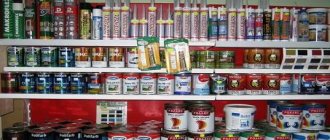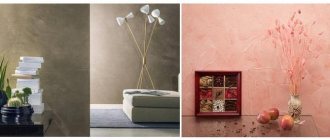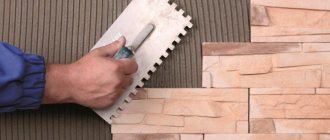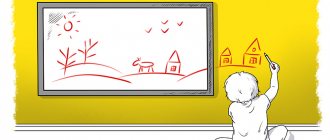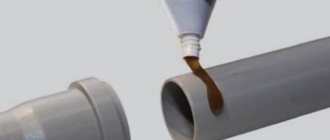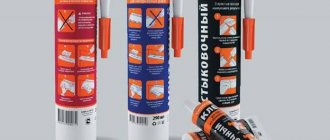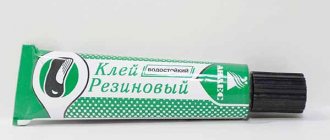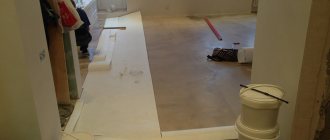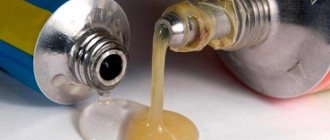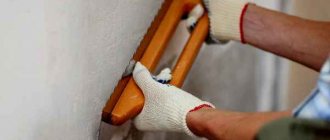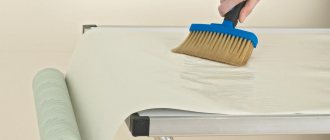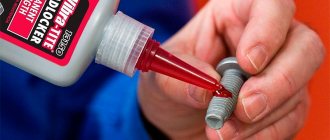Content
- 1 Acrylit 15 wallpaper glue Extra 1.1 Area of application
- 1.2 Properties and features:
- 1.3 Composition:
- 1.4 Method of application
- 2.1 Scope of application
- 3.1 Scope of application
- 4.1 Scope of application
- 5.1 Scope of application
- 6.1 Scope of application
- 7.1 Scope of application
Adhesive Acrylit 15 wallpaper Extra
For gluing vinyl and non-woven paper wallpapers, gluing paper and cardboard products
Application area
Specialized adhesive for gluing vinyl, non-woven and paper wallpapers, for gluing paper and cardboard products, pre-priming the surface to be glued, as a stationery adhesive, in bookbinding.
Properties and features:
- forms a transparent elastic film;
- has good adhesion to plasterboard, plaster, chipboard, fiberboard, OSB, wood, concrete, brick, etc.;
- has wide versatility of application;
- well suited for working with paper wallpaper and PVC-coated wallpaper; Guaranteed shelf life 12 months;
- does not leave yellow spots or streaks.
Compound:
Aqueous dispersion of acrylic copolymer, modifying additives.
Application method
The glue is applied in a continuous layer. Apply glue to the prepared wall surface, then align the wallpaper with the wall, press and smooth. Next, apply a uniform layer of glue to the front surface of the glued canvas, which will ensure dirt-repellent properties of the surface and improve adhesion to subsequent paint layers.
Adhesive Acrylit 15 wallpaper Extra
Latex based adhesive
The glue, created on a latex basis, is universal. It is used for almost any type of indoor work. It is used for gluing parquet, linoleum, ceramic and tiles and many other materials. Before application, the surface is cleaned of dirt, dust and degreased. Setting time is from half an hour to an hour.
Ceramic tile adhesive
Ceramic tiles can be glued to the surface using ordinary cement mortar, special mastic or cement-based adhesive mortar. Most often, cement-based glue is used in the work, since it is much cheaper than mastic. It is used for fastening ceramic tiles, tiles, slabs made of artificial or natural stone, with a strongly pronounced relief on the back side of the tile and in large sizes. First, glue is applied to the prepared surface and leveled, after which another layer is applied and the tiles are laid on it. This ensures maximum adhesion to the surface. After a day the glue dries, and after two days it gains strength. Mastic prepared on the basis of sodium silicate is applied to the surface in one thin layer. It hardens in three hours and dries in five days.
Glue Acrylit 43 Liquid tape
For gluing a wide variety of surfaces, including inert (passive) ones. Has the highest residual stickiness and adhesion.
Application area
“Liquid tape” is used for gluing a wide variety of surfaces, including inert (passive) ones. It has the highest stickiness and adhesion. The adhesive is used for interior work. Designed for gluing products made of ceramics, cork, wood, paper, cardboard, fabrics, as well as for gluing mosaics, type-setting linoleums (both on a woven and non-woven basis), polystyrene foam and polyurethane coatings on ceilings and walls. Can be used both on the facade of buildings and inside, as well as when finishing metal ventilation ducts; facilitates the installation of soundproofing and heat-insulating panels.
Properties and features:
- does not contain plasticizers and does not destroy the working substrate;
- after drying, the adhesive layer becomes transparent and sticky;
- stickiness remains for a long time;
- completely environmentally friendly and fire and explosion proof.
Compound:
Aqueous dispersion of acrylic copolymer, modifying additives.
Application method
“Liquid tape” is applied with a brush, roller (or poured automatically) in a continuous layer or dotted. The criterion for complete drying is the change in color of the glue from white to colorless. After this, the surfaces to be glued must be aligned and pressed for a few seconds. Considering the constant stickiness of contact glue, the surfaces to be glued can be opened and glued again. However, this leads to a decrease in adhesion. To increase the strength of the seam, it is recommended to apply glue to both surfaces to be glued. Drying time is approximately 1 hour under normal conditions. If applied in thick layers or on rough surfaces, or in low temperatures or high humidity, drying time may increase.
Glue Acrylit 43 Liquid tape
Adhesive Acrylit 44 Assembly, white
Designed to facilitate installation of most insulation materials
Application area
"Acrylit"-44 assembly adhesive (white) is designed to facilitate the installation of most insulation materials, both synthetic and natural based, when insulating building facades. Makes installation easier and more convenient. Possibility for one person to work without assistants. Reduces pulsating wind loads on the insulated facade due to the complete adhesion of the insulation to the wall. In wooden house construction it is used when installing insulating cord (isonel, velotherm) instead of a stapler and staples.
Properties and features:
- after drying, the adhesive layer becomes transparent and sticky;
- stickiness remains for a long time;
- It has high stickiness and adhesion to surfaces of various natures, including inert ones, such as polyethylene foam (PE), polyethylene (PP), polypropylene (PE), PET, etc.;
- with the formation of a strong adhesive connection, it has a good balance of adhesive and cohesive characteristics to various surfaces;
- forms a transparent film with permanent stickiness, characterized by good light fastness, aging resistance and moisture resistance;
- unlike others, the adhesive retains stickiness when the temperature drops, so it is used for insulation systems and adhesive tapes, adhesive tape, as well as various packaging tapes and materials;
- does not contain plasticizers and does not destroy the working substrate;
- after drying, the adhesive layer becomes transparent and sticky;
- stickiness remains for a long time.
Compound:
Aqueous dispersion of acrylic copolymer, modifying additives.
Application method
The adhesive composition is applied with a brush, roller (or by pouring automatically) in a continuous layer or dotted. The criterion for complete drying is the change in color of the glue from white to colorless. After this, the surfaces to be glued must be aligned and pressed for a few seconds. Considering the constant stickiness of contact glue, the surfaces to be glued can be opened and glued again. However, this leads to a decrease in adhesion. To increase the strength of the seam, it is recommended to apply glue to both surfaces to be glued. Drying time is approximately 1 hour under normal conditions. If applied in thick layers or on rough surfaces, or in low temperatures or high humidity, drying time may increase.
Adhesive Acrylit 44 Assembly, white
Water dispersion glue
In dispersion adhesives, the polymer (dispersed phase) is in water (dispersion medium) in the form of tiny spherical particles, the size of which can vary significantly, but usually does not exceed 0.25 microns. Larger particle sizes (0.5–2 µm) are typical for dispersions of PVA and other similar polymers. An essential component of the dispersion is an emulsifier , which ensures the stability of the monomer dispersion at the stage of its polymerization and the polymer dispersion after polymerization. To increase stability during storage and processing, a stabilizer . At the same time, the stabilizer can act as a thickener. Fillers, thickeners and other components are used not only in water-dispersion adhesives, but the mechanism of their interaction with the polymer in a liquid dispersion adhesive differs significantly from the interaction in adhesives in which water is a solvent.
Thus, the dispersion adhesive includes:
- polymer,
- water,
- emulsifier,
- stabilizer.
The main advantage of dispersion adhesives is the increased filler content. This leads to cheaper adhesive formulations due to reduced polymer consumption. Adhesives containing mineral fillers, for example polymer-cement adhesives/mastics based on PVA, may contain 4% polymer.
Emulsifiers and stabilizers, having high surface activity, form an adhesive seam when applied to the surface of the substrate, creating an increase in the adhesive bonds between the polymer and the substrate. The presence of a stabilizer and emulsifier in the dispersion adhesive increases the coalescence of latex particles during the gluing process as a result of evaporation or diffusion of the dispersion medium.
When dispersion adhesives are stored, chemical changes in the polymer in latex particles, thermal-oxidative destruction, structuring, and coagulation occur, so the stability of the adhesive system as a whole can significantly decrease.
During coagulation, as a result of the dissolution of the surfactant, the interaction of particles is facilitated. Also, stability decreases due to stirring or the introduction of fine fillers into the dispersion adhesive formulation, because the electrolyte begins to exert its influence and the pH of the system changes.
To stabilize the dispersion adhesive system, protective colloids - water-soluble polymers - are used. Moreover, the higher the content of water-soluble polymer, the higher the stability of the system. This is due to an increase in the viscosity of the system.
To successfully use dispersion adhesive, the system must have sufficient film-forming ability. A polymer that is unable to form a film under gluing conditions cannot serve as the basis for an adhesive. The most effective criterion for this ability is the minimum film formation temperature.
For a cold-curing dispersion adhesive system, dispersions with a film formation temperature of no higher than 4 - 12 ° C should be used. However, compositions containing film formers and plasticizers can be characterized by a higher film formation temperature without compromising the quality of the adhesive joint.
Repair and installation glue Acrylit 47, white
Designed for bonding most building materials
Application area
For carrying out internal and external repair and installation work: for gluing products made of polystyrene foam and polyurethane foam, gypsum, ceramics, wood, MDF, chipboard, cork. Can be used as a putty to seal defects or joints of surfaces.
Properties and features:
- has good strength properties;
- moisture resistant;
- non-toxic and non-flammable;
- forms an elastic white film;
- good adhesion to wood, concrete, brick, etc.
Compound:
Styrene-acrylic dispersion, modifying additives.
Application method
The glue is applied in a continuous layer or in dots with a diameter of 6 mm, depending on the complexity of the work. Align the surfaces to be glued and press them tightly against each other. The holding time under load depends on the shape of the surface and the rigidity of the glued material. Setting occurs within 10-15 minutes.
Repair and installation glue Acrylit 47, white
Adhesive Acrylit 47 repair and installation, colorless
Designed for gluing most building materials.
Application area
Used for interior and exterior repair and installation work, for durable bonding of most building materials: glass, wood, MDF, chipboard, laminate, parquet, metal, PVC, polystyrene foam, drywall, plaster, concrete, ceramics, etc.
Properties and features:
- has good strength properties;
- moisture resistant;
- non-toxic and non-flammable;
- forms an elastic colorless film;
- good adhesion to wood, concrete, brick, etc.
Compound:
Styrene-acrylic dispersion, modifying additives.
Application method
The glue is applied in a continuous layer or in dots with a diameter of 6 mm, depending on the complexity of the work. Align the surfaces to be glued and press them tightly against each other. The holding time under load depends on the shape of the surface and the rigidity of the glued material. Setting occurs within 10-15 minutes.
Adhesive Acrylit 47 repair and installation, colorless
Water-dispersed adhesive
It is a composition based on aqueous dispersion or polymer latex.
To achieve the required physicochemical, rheological, strength, performance and other properties, the formulations of aqueous adhesive materials contain fillers and necessary additives (stabilizers, thickeners, wetting agents, etc.).
Water-dispersed adhesive has a number of positive characteristics: good adhesive properties, excellent heat resistance, strength of the adhesive connection, easy removal of adhesive residues from working tools with water, good wetting of the surface with water, which allows the adhesive to be used for porous hygroscopic materials (wood, drywall, cement surfaces, styrofoam ( polystyrene foam), etc.) Special advantages that have ensured the widespread use of water-dispersed materials in production and in everyday life are environmental friendliness, absence of a strong odor, and fire safety.
When using polymer water-dispersed adhesives in various industries, there is no need for additional ventilation, recovery or disposal of solvents, wastewater treatment is greatly facilitated and the degree of environmental pollution is reduced. The use of polymer water-based adhesives dramatically reduces capital costs in production and significantly improves sanitary and hygienic working conditions.
The disadvantages of the glue include the relatively long drying and setting time, which occurs after complete evaporation of water, the possible development of microorganisms in it during long-term storage (to combat which, manufacturers introduce special additives into the glue), the need for transportation, storage and use at positive temperatures.
At temperatures below zero, irreversible changes occur in conventional water-based adhesives, therefore, in the Russian climate, frost-resistant adhesives, obtained using certain additives to the formulation, are more in demand.
Frost-resistant glue retains its technical and operational characteristics when exposed to negative temperatures, and frost-resistant glue can withstand freezing to -40°C followed by thawing to positive temperatures at least 5 times.
Depending on the base of the binder, water-dispersed adhesive can be polyvinyl acetate, ethylene vinyl acetate, acrylic, polyurethane, etc.
The technological characteristics of water-dispersion adhesives contribute to their widespread use in various industries: construction, woodworking and furniture, packaging, printing, tobacco, pulp and paper, leather, etc.
Our company produces a wide range of water-dispersed Homakoll adhesives for woodworking and furniture production - solid jointing, assembly gluing, laminating, postforming, cladding of relief surfaces on membrane and vacuum presses.
For construction, we produce adhesives for floor coverings for household and contract use (linoleum, carpet, parquet, PVC and carpet tiles, etc.), for wood, for wall and ceiling panels made of foam plastic. The range of products produced under the homa brand also includes frost-resistant brands of adhesive materials.
Adhesive Acrylit PAK 124 white and transparent
For carrying out internal and external repair and installation work, for durable bonding of most building materials.
Application area
For carrying out internal and external repair and installation work, for durable bonding of most building materials: glass, wood, MDF, chipboard, laminate, parquet, metal, polystyrene foam, plasterboard, concrete, ceramics, etc.
Properties and features:
- has good strength properties;
- moisture and weather resistant;
- non-toxic and non-flammable;
- forms an elastic film;
- has a high solids content;
- good adhesion to wood, concrete, brick, etc.;
- for external and internal works.
Compound:
Acrylic dispersion, titanium dioxide, filler, special additives, water.
Application method
The glue is applied in a continuous layer or in dots with a diameter of 5 mm, depending on the complexity of the work. Align the surfaces to be glued and press them tightly against each other. Drying time Drying criteria can be a change in the color of the glue from milky white to colorless and the appearance of transparency. Initial setting under load occurs within 10-15 minutes. Complete drying - after 24-48 hours under normal conditions. In some cases, due to the type of surface, the thickness of the applied layer and the nature of absorption, as well as low temperature and humidity, the drying time may be reduced or increased. One of the surfaces to be glued must be absorbent, otherwise it will increase the drying time. Adhesive Acrylit PAK 124 white and transparent
Floor glue. Which is better: silane, dispersion or polyurethane? on the Nedvio website
Question from a reader of our portal: Floor glue. Which is better: silane, dispersion or polyurethane?
Answer: The constant emergence of new finishing materials and floor coverings has contributed to the significant expansion of the range of construction adhesives. And today, many homeowners are faced with the question: “What adhesive would be the best choice?”
Looking ahead, let's say - always follow the manufacturer's instructions. On the packaging of parquet, tile, linoleum and laminate, as a rule, it is indicated what type of adhesive can be used. But if this data is not available, or if it is proposed to use universal floor chemicals for gluing the coating, then we advise you to read the recommendations below.
Choosing adhesive for the floor. What is important to know?
The choice between silane, dispersion, or polyurethane adhesive usually arises if you plan to glue parquet. All of these adhesive bases are equally good, although they certainly differ in composition and technical parameters. They are also distinguished by the durability of gluing parquet lamellas. And if you plan to make repairs for a long time, and the parquet itself is made of valuable wood, then this is undoubtedly an extremely important criterion.
Experts in laying parquet floors recommend choosing an adhesive that does not change the thickness of the layer after drying and shrinking. This property, as well as elasticity, is directly related to the reliable fastening of each lamella in its place, without shifting or squeaking.
When using floors in residential areas for a long time, it is important to pay attention to the environmental safety of the adhesive base. Please note: some adhesives may contain harmful solvents, although it should be noted that their number is small.
What are the differences between silane, dispersion and polyurethane floor adhesives?
Silane glue is universal. It can be used for laying floors made of any materials. It has the following characteristics:
- good elasticity and moisture-repellent properties;
- it is very durable, thanks to its thoughtful composition;
- good soundproofing qualities;
- This is an environmentally friendly material, it does not contain volatile substances and solvents;
- silane glue is convenient and practical to use;
- It is suitable for laying heated floors.
Dispersion glue is the best choice if you are for everything natural and environmentally friendly. It is made from a mixture of natural resins and water. It is well suited for reliable and durable installation of natural hardwood flooring such as oak, ash, etc.
Polyurethane floor adhesive is the best choice if durability is your priority. It also belongs to the universal class: you can glue not only wood to it, but also tiles, laminate, linoleum, etc.
As a rule, polyurethane adhesives are two-component: one package contains the adhesive base, and the other contains a hardener for it. Before laying the floor covering, they must be mixed with each other, but this must be done quickly (from 45 minutes to 2.5 hours), since the finished mixture hardens quickly. Floors laid on a polyurethane base can be used 24 hours after completion of work.
Cost of adhesive bases for floors
Price is always an important criterion, especially when it comes to finishing a large floor area in a private house. In this regard, dispersion adhesives are the most inexpensive, but silane adhesives are the most expensive.
Let's take as an example the price for 1 can of glue from the famous UZIN brand:
- Dispersion adhesive for PVC UZIN KE66 6 kg - RUB 3,500;
- Two-component polyurethane adhesive UZIN MK90 10 kg - 5,300 rubles;
- One-component silane adhesive UZIN MK200 16 kg - 16,900 rub.
As you can see: the difference in prices is quite significant. However, the durability of the floor varies. Especially if you plan to make a “warm floor” system. In this case, it is better to opt for silane glue, even if it costs more. The fact is that it does not lose strength and elasticity over time, even if there are frequent changes in temperature and humidity in the premises.
Did you find this article helpful? Please share it on social networks: Don't forget to bookmark the Nedvio website. We talk about construction, renovation, and country real estate in an interesting, useful and understandable way.
Acrylit PAK 127 white floor adhesive
For gluing household linoleum and carpet
Application area
For gluing household linoleum and carpet, it forms a white elastic film.
Properties and features:
- has water and weather resistance;
- has good fluidity, which makes it convenient when working on horizontal surfaces;
- elastic after complete drying;
- does not peel off when the floor is deformed;
- has good adhesion to wood, concrete, brick, glass, plastics, etc.;
- withstands freezing down to -18°C for no more than one month or five freeze-thaw cycles.
Compound:
The adhesive is applied to the surfaces to be bonded in accordance with the instructions for use of this flooring material. Continuous application followed by “combing” with a notched trowel is recommended.
Application method
Acrylic dispersion, titanium dioxide, filler, special additives, water.
Acrylit PAK 127 white floor adhesive
